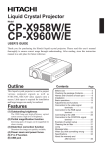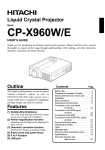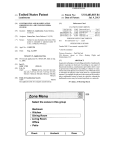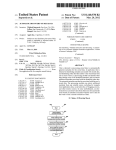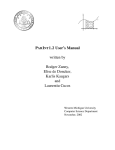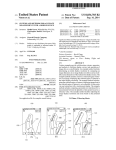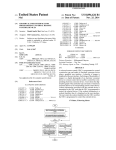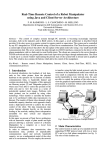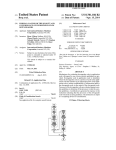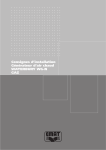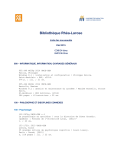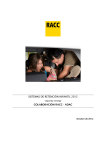Download Method and apparatus for selecting a playback queue in a multi
Transcript
US008886347B2 (12) United States Patent Lambourne (54) (56) METHOD AND APPARATUS FOR SELECTING A PLAYBACK QUEUE IN A MULTI-ZONE SYSTEM Inventor: Robert A Lambourne, Santa Barbara, CA (US) Notice: References Cited 5,182,552 A 1/1993 Paynting 5,946,343 A 8/1999 SchotZ et al. 6,587,127 B1 * 6,604,023 B1 * 7/2003 8/2003 6,631,410 B1 6,778,869 B2 7,130,608 B2 7,187,947 B1 7,218,708 B2 (73) Assignee: Sonos, Inc, Santa Barbara, CA (US) (*) Subject to any disclaimer, the term of this patent is extended or adjusted under 35 WO WO May 10, 2013 8/2004 Champion 10/2006 Hollstrom et al. 3/2007 White et al. 5/2007 Berezowski et al. 2005013047 A2 2012137190 A1 Rane: DragNet software; availabe for sale at least 2006* Yamaha DME Designer software manual: Copyright 2004* Sep. 26, 2013 Related US. Application Data (63) (Continued) Continuation of application No. 11/853,790, ?led on Sep. 11, 2007, now Pat. No. 8,483,853. (60) Provisional application No. 60/825,407, ?led on Sep. 12, 2006. (51) (52) Primary Examiner * Paul McCord (74) Attorney, Agent, or Firm * Hanley, Flight and Zimmerman, LLC Int. Cl. G06F 17/00 H03G 7/00 H04R 3/12 G06F 3/16 (2006.01) (2006.01) (2006.01) (2006.01) H04N21/436 (2011.01) (57) In general, techniques of controlling a plurality of multimedia US. Cl. CPC .. H03G 7/00 (2013.01); H04R 3/12 (2013.01); (2013.01) USPC ABSTRACT players in groups are disclosed. According to one aspect of the present invention, a mechanism is provided to allow a user G06F 3/16 (2013.01); H04N21/43615 (58) 2/2005 10/2012 OTHER PUBLICATIONS Prior Publication Data US 2013/0253679 A1 10/2003 Kowalski et al. FOREIGN PATENT DOCUMENTS (21) Appl. No.: 13/892,230 (65) Leeke et a1. ................ .. 715/765 Brown et al. ............... .. 700/276 (Continued) U.S.C. 154(b) by 0 days. (22) Filed: Nov. 11, 2014 U.S. PATENT DOCUMENTS (71) Applicant: Sonos, Inc., Santa Barbara, CA (US) (72) US 8,886,347 B2 (10) Patent N0.: (45) Date of Patent: .......................................................... .. 700/94 to group some of the players according to a theme or scene, where each of the players is located in a zone. When the scene is activated, the players in the scene react in a synchronized manner. For example, the players in the scene are all caused to play a multimedia source or music in a playlist, wherein the multimedia source may be located anywhere on a network. Field of Classi?cation Search None See application ?le for complete search history. 20 Claims, 11 Drawing Sheets 240 244 242 246 248 ow Playing Scroll Wheel 250 252 US 8,886,347 B2 Page 2 (56) References Cited United States Patent and Trademark Of?ce,“Non-Final Of?ce U.S. PATENT DOCUMENTS Action”, issued in connection with US. Appl. No. 13/013,740, mailed on Sep. 27, 2013, 12 pages. Voyetra Turtle Beach, Inc., AudioTron Setup Guide, Version 3 .0,May 7,302,468 B2 11/2007 Wijeratne 7,539,551 7,558,224 7,571,014 7,626,952 7,643,894 5/2009 7/2009 8/2009 12/2009 1/2010 B2 B1 B1 B2 B2 7,668,990 B2 7,742,832 B1 Komura et a1. Surazski et al. Lambourne et al. Slemmer et al. Braithwaite et a1. 2/2010 Krzyzanowski et al. 6/2010 Feldman et al. 2002,38 pages. International Bureau, “Search Report”, issued in connection with International patent Application No. PCT/IB2012/052071, mailed on Aug. 23, 2012, 3 pages. Jo J ., et al., “Synchronized One-to-many Media Streaming with Adaptive Playout Control,” Proceedings of SPIE, 2002, vol. 4861, pp. 71-82. Mills D.L., “Network Time Protocol (Version 3) Speci?cation, Implementation and Analysis,” Network Working Group, Mar. 1992, 7,761,176 B2 7,805,210 B2 7,817,960 B2 7/2010 Ben-Yaacov et al. 9/2010 Cucos et al. 10/2010 Tan et al. “Polycom Conference Composer manual: copyright 2001”, 29 7,849,181 B2* 12/2010 pages. Slemmer et al. ............ .. 709/223 7,962,482 B2 6/2011 Handman et al. 8,045,952 B2 10/2011 Quresheyet a1. 8,189,824 B2 5/2012 Strauss et al. 8,234,395 B2 8,239,559 B2 7/2012 Millington 8/2012 Rajapakse 8,290,603 B1 10/2012 Lambourne 8,700,730 B2* 2002/0002039 2002/0003548 2002/0072816 2002/0124097 2003/0020763 2003/0167335 2003/0177889 A1 A1 A1 A1 A1 A1 A1 2003/0198257 A1* 2004/0010727 A1 2004/0015252 2004/0117044 2004/0131192 2004/0223622 2004/0225389 2005/0002535 2005/0021470 2005/0131558 2005/0144284 A1 A1 A1 A1 A1 A1 A1 A1 A1 4/2014 Rowe .......................... .. 709/217 1/2002 Quresheyet a1. 1/2002 Krusche et a1. 6/2002 Shdema et al. 9/2002 Iselyetal. 1/2003 Mayeret a1. 9/2003 Alexander 9/2003 Kosekiet al. 10/2003 Sullivan et al. ............. .. 370/516 1/2004 Fujinami 1/2004 6/2004 7/2004 11/2004 11/2004 1/2005 1/2005 6/2005 6/2005 Aiso et a1. Konetski Metcalf Lindemann et al. LedouX et al. Liu et al. Martin et al. Braithwaite et a1. Ludwig et al. 2005/0254505 A1* 11/2005 Chang et a1. ................ .. 370/401 2005/0289224 2005/0289244 2006/0041616 2006/0149402 2007/0142022 2007/0142944 2007/0189544 2007/0288610 2008/0025535 2008/0045140 12/2005 12/2005 2/2006 7/2006 6/2007 6/2007 8/2007 12/2007 1/2008 2/2008 Deslippe et al. Sahu etal. Ludwig et al. Chung Madonna et al. Goldberg et al. Rosenberg Saint Clair et al. Rajapakse Korhonen A1 A1 A1 A1 A1 A1 A1 A1 A1 A1 2008/0066094 A1* 3/2008 Igoe .............................. .. 725/25 2008/0066120 A1 3/2008 Igoe 2008/0077261 2008/0144861 2008/0152165 2008/0162668 2009/0097672 3/2008 6/2008 6/2008 7/2008 4/2009 A1 A1 A1 A1 A1 2009/0228919 A1* Baudino et al. Melanson et al. Zacchi Miller Builet al. 9/2009 Zott et al. ...................... .. 725/34 OTHER PUBLICATIONS Co-pending U.S. Appl. No. 13/083,499, ?led Apr. 8, 2011, 69 pages. United States Patent and Trademark Of?ce, “Final Of?ce Action”, issued in connection with US. Appl. No. 13/013,740, mailed on Feb. 10, 2014, 13 pages. International Bureau, “International preliminary report on patent ability,” issued in connection with International Patent Application No. PCT/IB2012/052071, mailed Oct. 17, 2013, 7 pages. <http://www.ietf.org/rfc/rfc1305.D<t>, 7 pages. International Bureau, “Written Opinion”, issued in connection with International patent Application No. PCT/IB2012/052071, mailed on Aug. 23, 2012, 6 pages. United; States Patent and Trademark Of?ce., “Advisory Action mailed Dec. 22, 2011 for US. Appl. No. 11/853,790, ?led Sep. 11, 2007”, Dec. 22, 2011, 2 pages. United; States Patent and Trademark Of?ce., “Final Of?ce Action mailed Oct. 13, 2011 for US. Appl. No. 11/853,790, ?led Sep. 11, 2007”, Nov. 13, 2011, 10 pages. United; States Patent and Trademark Of?ce., “Notice of Allowability mailed Apr. 18, 2013 for US. Appl. No. 11/853,790, ?led Sep. 11, 2007”, Apr. 18, 2013, 4 pages. United; States Patent and Trademark Of?ce., “Of?ce Action mailed Mar. 8, 2011 for US. Appl. No. 11/853,790, ?led Sep. 11, 2007”, Mar. 8,2011, 10 pages. “UPnP; ”Universal Plug and Play Device Architecture“; Jun. 8, 2000; version 1.0; Microsoft Corporation; pp. 1-54”. Voyetra; Turtle Beach Inc., “AudioTron Quick Start Guide, Version 1.0”, Mar. 2001, 24 pages. Voyetra; Turtle Beach Inc., “AudioTron Reference Manual, Version 3.0”, May 2002, 70 pages. Voyetra; Turtle Beach Inc., “AudioTron Setup Guide, Version 3.0”, May 2002, 32 pages. “Yamaha DME 32 manual”: copyright 2000, pp. 296. The United States Patent and Trademark Of?ce, “Non-Final Of?ce Action”, issued in connection with US. Appl. No. 13/896,829, mailed on Jan. 7, 2014, 11 pages. The United States Patent and Trademark Of?ce, “Non-Final Of?ce Action”, issued in connection with US. Appl. No. 13/083,499, mailed Feb. 10, 2014, 12 pages. The United States Patent and Trademark Of?ce, “Notice of Allow ance”, issued in connection with US. Appl. No. 13/083,499, mailed on Jun. 2, 2014, 5 pages. The United States Patent and Trademark Of?ce, “Notice of Allow ance”, issued in connection with US. Appl. No. 13/896,829, mailed on Jun. 12,2014, 5 pages. United States Patent and Trademark Of?ce, “Final Of?ce Action”, issued in connection with US. Appl. No. 13/896,037, mailed on Jul. 23,2014, 12 pages. United States Patent and Trademark Of?ce, “Non-Final Of?ce Action”, issued in connection with US. Appl. No. 14/256,434, mailed Jul. 23, 2014, 12 pages. Yamaha, “DME 64 Owner’s Manual”, copyright 2004, 80 pages. Yamaha, “DME Designer 3.5 setup manual guide”, copyright 2004, 16 pages. Yamaha, “DME Designer 3.5 User Manual”, Copyright 2004, 507 pages. (Document uploaded in 5 different ?les: -. NPLSipartl pp. 1 to 128, -. NPLSipart2 pp. 129 to 263 -. NPLSipart3 pp. 264 to 378 -. NPLSipart4 pp. 379 to 471. * cited by examiner US. Patent OH NOV. 11, 2014 00 Sheet 1 0f 11 US 8,886,347 B2 US. Patent NOV. 11, 2014 us 8,886,347 B2 Sheet 2 0f 11 com .QI<N US. Patent owm NOV.11,2014 US 8,886,347 B2 Sheet30f11 wa 7/ 3NmvmNvmwvm vmm US. Patent NOV. 11, 2014 co/mbw NNN cwmbw /$2.5 EN US 8,886,347 B2 Sheet 4 0f 11 - 869:025 www /) /EQE20:2 fwomtacl AmogtzhvE / / ow~ .QE0N www US. Patent NOV. 11, 2014 Sheet 5 0f 11 US 8,886,347 B2 g .QE wcomEr?Nsg UmPCB .QED QEDEDGE .1r meta.l-,Eo m US. Patent NOV. 11, 2014 Sheet 6 0f 11 US 8,886,347 B2 Mm GE 5:5PFCODVW—E 350mEgo. 7. . US. Patent NOV. 11, 2014 :p39.502:? 5QU.E-53m Sheet 7 0f 11 mocok.- .QIv 39m mum t_w MmuVwx_.m8.,mwé : mini US 8,886,347 B2 31.EB;mcwm .B! 8 _auE5H:2E.t6:5a.-:wc US. Patent NOV. 11, 2014 US 8,886,347 B2 Sheet 8 0f 11 =1, a _ w __ E v6 ?ncmu?w HEmoswm. Waw>.Emoe3?:u_=m>I 5moac0>uwm @M@gggQB:U PM 9 c0552:008,7 m®Wy.t“5ma0e9b10.:ch “nuW>05E.=3oE>1m.: @Eohu6mi?3zm am%&Eoimuanm.th m$56:0523a2c.a»%w mm96:_.c38o.2w§5 J US. Patent Nov. 11,2014 Sheet 9 0f 11 US 8,886,347 B2 .GEMm omm 5 1.1254“3?:) E?m m . 5&5 .._1._.1m.. Enum m um ,.1 1. .5ch .1 w 1 1. 1.1 1 § US. Patent NOV. 11, 2014 US 8,886,347 B2 Sheet 11 0f 11 N5\\ oom =26\k Now 05 v0:2mm9o89w\\053%; @5m968 283¢ \3£9:69568,3 9:£2\o_0>6m8n>w93 " ?l ] oxmo>£ 283¢ \x9629:5om23596>c0m%o3 w22uN:cEm0o96>m 9:209>5m_Mn US 8,886,347 B2 1 2 METHOD AND APPARATUS FOR SELECTING A PLAYBACK QUEUE IN A MULTI-ZONE SYSTEM living room are grouped for the music. Over the weekend, the audio players in the den, the living room, and a kitchen are grouped for party music. Because the morning group, the evening group and the weekend group contain the den, it can be dif?cult for the traditional system to accommodate the CROSS REFERENCE TO RELATED APPLICATION requirement of dynamically managing the ad hoc creation and deletion of groups. There is a need for dynamic control of the audio players as a group. With a minimum manipulation, the audio players may be readily grouped. In a traditional multi-zone audio system, the audio players have to be adjusted one at a time, resulting in an inconvenient and non-homogenous audio environment. Further, there is a need to individually or sys This application is a continuation of and claims priority to patent application Ser. No. 11/853,790, ?led Sep. 11, 2007, entitled “CONTROLLING AND MANIPULATING GROUPINGS INA MULTI-ZONE MEDIA SYSTEM,” and US. Provisional Application No. 60/825,407 ?led on Sep. 12, 2006, entitled “CONTROLLING AND MANIPULATING GROUPINGS IN A MULTI-ZONE MEDIA SYSTEM,” tematically adjust the audio volume of the audio players. each of which is hereby incorporated by reference in its entirety for all purposes. SUMMARY OF THE INVENTION BACKGROUND OF THE INVENTION Field of the Invention 20 This section is for the purpose of summarizing some aspects of the present invention and to brie?y introduce some preferred embodiments. Simpli?cations or omissions in this The invention is generally related to the area of consumer section as well as in the abstract or the title of this description electronics and human-computer interaction. In particular, may be made to avoid obscuring the purpose of this section, the abstract and the title. Such simpli?cations or omissions the invention is related to method and apparatus for control ling or manipulating a plurality of multimedia players in a 25 are not intended to limit the scope of the present invention. multi-zone system. An enduring passion for quality audio reproduction or In general, the present invention pertains to controlling a plurality of multimedia players, or simply players, in groups. system is continuing to drive demands from users. One of the demands includes an audio system in a house in which, for example, one could grill to classic rock on a patio while According to one aspect of the present invention, a mecha 30 another one may cook up his/her own music selections in a kitchen. This is all at the same time while a teenager catches a ballgame in a family room, and another one blasts pop in a bedroom. And the best part of such audio system is that each family member does not need his or her own stereo systemi one system gives everyone access to all the music sources. Currently, one of the systems that can meet part of such demand is a conventional multi-zone audio system that usu 35 nism is provided to allow a user to group some of the players according to a theme or scene, where each of the players is located in a zone. When the scene is activated, the players in the scene react in a synchronized manner. For example, the players in the scene are all caused to play an audio source or music in a playlist, wherein the audio source may be located anywhere on a network. According to another aspect of the present invention, the scene may be activated at any time or a speci?c time. A user may activate the scene at any time so that only some selected ally includes a number of audio players. Each of the audio players has its own ampli?er(s) and a set of speakers and 40 zones in an entertainment system facilitate a playback of an audio source. When the scene is activated at a speci?c time, typically installed in one place (e.g., a room). In order to play the scene may be used as an alarm or buzzer. an audio source at one location, the audio source must be According to still another aspect of the present invention, a controlling device (also referred to herein as controller) is provided locally or from a centralized location. When the audio source is provided locally, the multi-zone audio system functions as a collection of many stereo systems, making source sharing dif?cult. When the audio source is provided 45 centrally, the centralized location may include a juke box, many compact discs, an AM or FM radio, tapes, or others. To send an audio source to an audio player demanding such source, a cross-bar type of device is used to prevent the audio provided to facilitate a user to select any of the players in the system to form respective groups each of which is set up per a scene. Although various scenes may be saved in any of the members in a group, commands are preferably sent from the controller to the rest of the members when one of the scenes source from going to other audio players that may be playing is executed. Depending on implementation, the commands include parameters pertaining to identi?ers of the players, other audio sources. volumes settings, audio source and etc. 50 In order to achieve playing different audio sources in dif According to yet another aspect of the present invention, a ferent audio players, the traditional multi-zone audio system is generally either hard-wired or controlled by a pre-con?g ured and pre-programmed controller. While the pre-pro grammed con?guration may be satisfactory in one situation, con?gurable module is implemented in the controlling device that provides interactive graphic user interface for forming, managing and controlling groups in the system, de-grouping 55 a group or adjusting audio volume of individual players or a it may not be suitable for another situation. For example, a person would like to listen to broadcast news from his/her group of players. The present invention may be implemented in many forms favorite radio station in a bedroom, a bathroom and a den including software, hardware or a combination of both. According to one embodiment, the present invention is while preparing to go to work in the morning. The same person may wish to listen in the den and the living room to music from a compact disc in the evening. In order to satisfy such requirements, two groups of audio players must be established. In the morning, the audio players in the bedroom, the bathroom and the den need to be grouped for the broadcast news. In the evening, the audio players in the den and the directed to a method for groupings in a multi-zone media system, the method comprises providing a mechanism to 65 allow a user to determine which players in the system to be associated with a theme representing a group; and con?gur ing the theme with parameters pertaining to the players, wherein the theme is activated at anytime or a speci?c time so US 8,886,347 B2 3 4 that the players react in a synchronized manner. The players in processing devices coupled to networks. These process descriptions and representations are typically used by those a scene are synchronized to play a multimedia ?le when the scene is activated. skilled in the art to most effectively convey the substance of their work to others skilled in the art. Numerous speci?c details are set forth in order to provide a thorough understand According to another embodiment, the present invention is directed to an entertainment system for grouping players, the system comprises: a plurality of players, each located in one ing of the present invention. However, it will become obvious zone; and a controller providing a mechanism to allow a user to those skilled in the art that the present invention may be to select which of the players to be associated with a theme representing a group; and con?gure the theme with param eters pertaining to the selected players, wherein the theme is practiced without these speci?c details. In other instances, well known methods, procedures, components, and circuitry activated at anytime or a speci?c time so that the selected players react in a synchronized manner. As a result, the obscuring aspects of the present invention. have not been described in detail to avoid unnecessarily invention is to remotely control a plurality of multimedia Reference herein to “one embodiment” or “an embodi ment” means that a particular feature, structure, or character istic described in connection with the embodiment can be included in at least one embodiment of the invention. The appearances of the phrase “in one embodiment” in various players in a multi-zone system, playing and controlling the audio source synchronously if the players are grouped the same embodiment, nor are separate or alternative embodi selected players are synchronized to play a multimedia that is in a digital format and retrieved from a source over a network. One of the objects, features, and advantages of the present together, or playing and controlling the audio source indi vidually if the players are disassociated with each other. places in the speci?cation are not necessarily all referring to 20 ments mutually exclusive of other embodiments. Further, the order of blocks in process ?owcharts or diagrams represent Other objects, features, and advantages of the present ing one or more embodiments of the invention do not inher invention will become apparent upon examining the follow ing detailed description of an embodiment thereof, taken in ently indicate any particular order nor imply any limitations conjunction with the attached drawings. 25 BRIEF DESCRIPTION OF THE DRAWINGS in the invention. Referring now to the drawings, in which like numerals refer to like parts throughout the several views. FIG. 1 shows an exemplary con?guration 100 in which the present inven tion may be practiced. The con?guration may represent, but These and other features, aspects, and advantages of the present invention will become better understood with regard to the following description, appended claims, and accompa not be limited to, a part of a residential home, a business building or a complex with multiple zones. There are a num 30 nying drawings where: FIG. 1 shows an exemplary con?guration in which the present invention may be practiced; FIG. 2A shows an exemplary functional block diagram of a player in accordance with the present invention; and 106 are shown as audio devices. Each of the audio devices may be installed or provided in one particular area or zone and hence referred to as a zone player herein. As used herein, unless explicitly stated otherwise, an audio 35 understanding of the present invention, it is assumed that the con?guration 100 represents a home. Thus, the zone player 40 FIG. 3A provides an illustration of one zone scene, where the left column shows the starting zone groupingiall zones are separate, the column on the right shows the effects of grouping the zones to make a group of 3 zones named after “Morning”; source or audio sources are in digital format and can be transported or streamed over a data network. To facilitate the FIG. 2B shows an example of a controller that may be used to remotely control one of more players of FIG. 2A; FIG. 2C shows an exemplary internal functional block diagram of a controller in accordance with one embodiment of the present invention; ber of multimedia players of which three examples 102, 104 45 102 and 104 may be located in two of the bedrooms respec tively while the zone player 106 may be installed in a living room. All of the zone players 102, 104 and 106 are coupled directly or indirectly to a data network 108. In addition, a computing device 110 is shown to be coupled on the network 108. In reality, any other devices such as a home gateway device, a storage device, or an MP3 player may be coupled to the network 108 as well. The network 108 may be a wired network, a wireless net work or a combination of both. In one example, all devices FIG. 3B shows that a user de?nes multiple groups to be gathered at the same time; FIG. 4 shows an exemplary user interface that may be displayed on a controller or a computer of FIG. 1; including the zone players 102, 104 and 106 are coupled to FIG. 5A shows a user interface to allow a user to form a 50 the network 108 by wireless means based on an industry standard such as IEEE 802.11. In yet another example, all devices including the zone players 102, 104 and 106 are part scene; FIG. 5B shows another user interface 520 to allow a user to form a scene; FIG. 5C shows a user interface to allow a user to adjust a volume level of the zone players in a zone scene individually of a local area network that communicates with a wide area network (e.g., the Internet). 55 or collectively; and FIG. 6 shows a ?owchart or process of providing a player Many devices on the network 108 are con?gured to down load and store audio sources. For example, the computing device 110 can download audio sources from the Internet and theme or a zone scene for a plurality of players, where one or store the downloaded sources locally for sharing with other more of the players are placed in a zone. devices on the Internet or the network 108. The computing device 110 or any of the zone players can also be con?gured to receive streaming audio. Shown as a stereo system, the device 112 is con?gured to receive an analog audio source (e.g., from broadcasting) or retrieve a digital audio source 60 DETAILED DESCRIPTION OF THE PREFERRED EMBODIMENTS The detailed description of the invention is presented largely in terms of procedures in terms of procedures, steps, logic blocks, processing, and other symbolic representations (e.g., from a compact disk). The analog audio sources can be converted to digital audio sources. In accordance with the present invention, the audio source may be shared among the that directly or indirectly resemble the operations of data devices on the network 108. 65 US 8,886,347 B2 6 5 include necessary circuitry to process analog signals as inputs to produce digital signals for sharing with other devices on a Two or more zone players may be grouped together to form a new zone group. Any combinations of zone players and an network. Depending on an exact implementation, the module 212 may be implemented as a combination of hardware and soft existing zone group may be grouped together. In one instance, a new zone group is formed by adding one zone player to another zone player or an existing zone group. ware. In one embodiment, the module 212 is used to save a Referring now to FIG. 2A, there is shown an exemplary functional block diagram of a zone player 200 in accordance with the present invention. The zone player 200 includes a network interface 202, a processor 204, a memory 206, an audio processing circuit 210, a module 212, and optionally, an audio ampli?er 214 that may be internal or external. The scene. The audio ampli?er 214 is typically an analog circuit that powers the provided analog audio signals to drive one or more speakers. Referring now to FIG. 2B, there is shown an exemplary controller 240, which may correspond to the controlling device 140 or 142 of FIG. 1. The controller 240 may be used to facilitate the control of multi-media applications, automa network interface 202 facilitates a data ?ow between a data network (i.e., the data network 108 of FIG. 1) and the zone player 200 and typically executes a special set of rules (i.e., a protocol) to send data back and forth. One of the common protocols used in the Internet is TCP/IP (Transmission Con trol Protocol/ Internet Protocol). In general, a network inter face manages the assembling of an audio source or ?le into smaller packets that are transmitted over the data network or tion and others in a complex. In particular, the controller 240 is con?gured to facilitate a selection of a plurality of audio sources available on the network, controlling operations of one or more zone players (e. g., the zone player 200) through a RF interface corresponding to the RF interface 216 of FIG. 2A. According to one embodiment, the wireless means is 20 based on an industry standard (e.g., infrared, radio, wireless The network interface 202 may include one or both of a 25 standard IEEE 802.1 la, 802.1 lb or 802.11g). When a par ticular audio source is being played in the zone player 200, a picture, if there is any, associated with the audio source may be transmitted from the zone player 200 to the controller 240 for display. In one embodiment, the controller 240 is used to synchronize more than one zone players by grouping the zone players in a group. In another embodiment, the controller 240 is used to control the volume of each of the zone players in a zone group individually or together. reassembles received packets into the original source or ?le. In addition, the network interface 202 handles the address part of each packet so that it gets to the right destination or intercepts packets destined for the zone player 200. wireless interface 216 and a wired interface 217. The wireless interface 216, also referred to as a RF interface, provides network interface functions by a wireless means for the zone player 200 to communicate with other devices in accordance with a communication protocol (such as the wireless standard IEEE 802.1 la, 802.1 lb or 802.11g). The wired interface 217 30 provides network interface functions by a wired means (e.g., an Ethernet cable). In one embodiment, a zone player includes both of the interfaces 216 and 217, and other zone players include only a RF or wired interface. Thus these other 35 retrieve audio sources via the zone player. The processor 204 is con?gured to control the operation of otherparts in the zone player 200. The memory 206 may be loaded with one or more 244 activates a zone management screen or “Zone Menu”, 40 embodiment of the present invention is executed, the proces sor 204 operates in accordance with the software module in reference to a saved zone group con?guration characterizing a zone group created by a user, the zone player 200 is caused 45 to retrieve an audio source from another zone player or a device on the network. According to one embodiment of the present invention, the memory 206 is used to save one or more saved zone con?gu 50 ration ?les that may be retrieved for modi?cation at any time. Typically, a saved zone group con?guration ?le is transmitted to a controller (e.g., the controlling device 140 or 142 of FIG. which is described in more details below. The “back” button 246 may lead to different actions depending on the current screen. In one embodiment, the “back” button triggers the current screen display to go back to a previous one. In another embodiment, the ‘back” button negates the user’s erroneous selection. The “music” button 248 activates a music menu, which allows the selection of an audio source (e.g., a song) to be added to a zone player’s music queue for playback. The scroll wheel 250 is used for selecting an item within a list, whenever a list is presented on the screen 242. When the items in the list are too many to be accommodated in one screen display, a scroll indicator such as a scroll bar or a scroll arrow is displayed beside the list. When the scroll indicator is 1, a computer, a portable device, or a TV) when a user oper ates the controlling device. The zone group con?guration up/down button 264, a set of soft buttons 266 corresponding to the labels 268 displayed on the screen 242. The screen 242 displays various screen menus in response to a user’s selection. In one embodiment, the “zones” button zone players communicate with other devices on a network or software modules that can be executed by the processor 204 to achieve desired tasks. According to one aspect of the present invention, a software module implementing one The user interface for the controller 240 includes a screen 242 (e.g., a LCD screen) and a set of functional buttons as follows: a “zones” button 244, a “back” button 246, a “music” button 248, a scroll wheel 250, “ok” button 252, a set of transport control buttons 254, a mute button 262, a volume 55 provides an interactive user interface so that various manipu lations or control of the zone players may be performed. displayed, a user may rotate the scroll wheel 250 to either choose a displayed item or display a hidden item in the list. The “ok” button 252 is used to con?rm the user selection on the screen 242. There are three transport buttons 254, which are used to control the effect of the currently playing song. For example, the functions of the transport buttons may include play/pause The audio processing circuit 210 resembles most of the circuitry in an audio playback device and includes one or more digital-to-analog converters (DAC), an audio prepro 60 and forward/rewind a song, move forward to a next song cessing part, an audio enhancement part or a digital signal track, or move backward to a previous track. According to one processor and others. In operation, when an audio source is retrieved via the network interface 202, the audio source is embodiment, pressing one of the volume control buttons such processed in the audio processing circuit 210 to produce analog audio signals. The processed analog audio signals are then provided to the audio ampli?er 214 for playback on speakers. In addition, the audio processing circuit 210 may 65 as the mute button 262 or the volume up/ down button 264 activates a volume panel. In addition, there are three soft buttons 266 that can be activated in accordance with the labels 268 on the screen 242. It can be understood that, in a multi zone system, there may be multiple audio sources being US 8,886,347 B2 7 8 played respectively in more than one zone players. The music tion. In the above description, unless otherwise speci?cally transport functions described herein shall apply selectively to one of the sources when a corresponding one of the zone described, it is clear that keys or buttons are generally referred to as either the physical buttons or soft buttons, enabling a players or zone groups is selected. user to enter a command or data. FIG. 2C illustrates an internal functional block diagram of an exemplary controller 270, which may correspond to the music playback is to link a number of zone players together to controller 240 of FIG. 2B. The screen 272 on the controller 270 may be a LCD screen. The screen 272 communicates form a group. To link a number of zone players together, a user may manually link each zone player or room one after the One mechanism for ‘joining’ zone players together for with and is commanded by a screen driver 274 that is con other. For example, there is a multi-zone system that includes the following zones. Bathroom Bedroom Den trolled by a microcontroller (e.g., a processor) 276. The memory 282 may be loaded with one or more application modules 284 that can be executed by the microcontroller 276 with or without a user input via the user interface 278 to achieve desired tasks. In one embodiment, an application module is con?gured to facilitate grouping a number of Dining Room Family Room selected zone players into a zone group and synchronizing the zone players for one audio source. In another embodiment, an Foyer application module is con?gured to control together the audio volumes of the zone players in a zone group. In operation, when the microcontroller 276 executes one of the application 20 If the user wishes to link 5 of the 6 zone players using the current mechanism, he/ she must start with a single zone and then manually link each zone to that zone. This mechanism modules 284, the screen driver 274 generates control signals may be sometimes quite time consuming. According to one to drive the screen 272 to display an application speci?c user interface accordingly, more of which will be described below. The controller 270 includes a network interface 280 together using one command. Using what is referred to herein embodiment, a set of zones can be dynamically linked as a theme or a zone scene, zones can be con?gured in a referred to as a RF interface 280 that facilitates wireless 25 particular scene (e.g., morning, afternoon, or garden), where communication with a zone player via a corresponding RF a prede?ned zone grouping and setting of attributes for the grouping are automatically effectuated. interface thereof. In one embodiment, the commands such as volume control and audio playback synchronization are sent via the RF interfaces. In another embodiment, a saved zone group con?guration is transmitted between a zone player and a controller via the RF interfaces. The controller 270 may control one or more zone players, such as 102, 104 and 106 of FIG. 1. Nevertheless, there may be more than one controllers, For instance, a “Morning” zone scene/con?guration com 30 3A provides an illustration of one zone scene, where the left column shows the starting zone groupingiall zones are sepa rate, the column on the right shows the effects of grouping the each preferably in a zone (e.g., a room) and con?gured to control any one and all of the zone players. 35 In one embodiment, a user creates a zone group including at least two zone players from the controller 240 that sends signals or data to one of the zone players. As all the zone players are coupled on a network, the received signals in one zone player can cause other zone players in the group to be mand would link the Bedroom, Den and Dining Room together in one action. Without this single command, the user would need to manually and individually link each zone. FIG. zones to make a group of 3 zones named after “Morning”. Expanding this idea further, a Zone Scene can be set to create multiple sets of linked zones. For example, a scene creates 3 separate groups of zones, the downstairs zones would be linked together, the upstairs zones would be linked back an identical audio source or a list of identical audio together in their own group, and the outside zones (in this case the patio) would move into a group of its own. In one embodiment as shown in FIG. 3B, a user de?nes sources in a timely synchronized manner. Similarly, when a user increases the audio volume of the group from the con multiple groups to be gathered at the same time. For example: an “Evening Scene” is desired to link the following zones: 40 synchronized so that all the zone players in the group play troller, the signals or data of increasing the audio volume for 45 zone players in the group to be increased together in volume and in scale. According to one implementation, an application module is loaded in memory 282 for zone group management. When Group 1 Bedroom Den the group are sent to one of the zone players and causes other Dining Room Group 2 50 a predetermined key (e.g. the “zones” button 244) is activated Garage Garden where Bathroom, Family Room and Foyer should be sepa on the controller 240, the application module is executed in the microcontroller 276. The input interface 278 coupled to rated from any group if they were part of a group before the and controlled by the microcontroller 276 receives inputs Zone Scene was invoked. from a user. A “Zone Menu” is then displayed on the screen 55 One important of the features, bene?ts and objects in the present invention is that that zones do not need to be separated 272. The user may start grouping zone players into a zone group by activating a “Link Zones” or “Add Zone” soft but ton, or de-grouping a zone group by activating an “Unlink Zones” or “Drop Zone” button. The detail of the zone group manipulation will be further discussed below. As described above, the input interface 278 includes a before a zone scene is invoked. In one embodiment, a com mand is provided and links all zones in one step, if invoked. 60 following attributes: number of function buttons as well as a screen graphical user Set volumes levels in each zones (each zone can have a interface. It should be pointed out that the controller 240 in FIG. 2B is not the only controlling device that may practice the present invention. Other devices that provide the equiva lent control functions (e.g., a computing device, a hand-held device) may also be con?gured to practice the present inven The command is in a form of a zone scene. After linking the appropriate zones, a zone scene command could apply the different volume) Mute/Unmute zones. 65 Select and play speci?c music in the zones. Set the play mode of the music (Shuf?e, Repeat, Shuf?e repeat) US 8,886,347 B2 10 Set the music playback equalization of each zone (e.g., 600 is presented in accordance with one embodiment of the present invention and may be implemented in a module to be located in the memory 282 of FIG. 2C. The process 600 is initiated only when a user decides to bass treble). A further extension of this embodiment is to trigger a zone scene command as an alarm clock function. For instance the zone scene is set to apply at 8:00 am. It could link appropriate proceed with a zone scene at 602. The process 600 then moves to 604 where it allows a user to decide which zone players to zones automatically, set speci?c music to play and then stop the music after a de?ned duration. Although a single zone be associated with the scene. For example, there are ten players in a household, and the scene is named after “Mom ing”. The user may be given an interface to select four of the ten players to be associated with the scene. At 606, the scene is saved. The scene may be saved in any one of the members in the scene. In the example of FIG. 1, the scene is saved in one of the zone players and displayed on the controller 142. In operation, a set of data pertaining to the scene includes a may be assigned to an alarm, a scene set as an alarm clock provides a synchronized alarm, allowing any zones linked in the scene to play a prede?ned audio (e. g., a favorable song, a prede?ned playlist) at a speci?c time or for a speci?c dura tion. If, for any reason, the scheduled music failed to be played (e. g., an empty playlist, no connection to a share, failed UPnP, no Internet connection for an Internet Radio plurality of parameters. In one embodiment, the parameters include, but may not be limited to, identi?ers (e. g., IP address) of the associated players and a playlist. The parameters may also include volume/tone settings for the associatedplayers in station), a backup buzzer will sound. This buzzer will be a sound ?le that is stored in a zone player. FIG. 4 shows an exemplary user interface 400 that may be displayed on a controller 142 or a computer 110 of FIG. 1. The interface 400 shows a list of items that may be set up by a user to cause a scene to function at a speci?c time. In the embodi the scene. The user may go back to 602 to con?gure another 20 ment shown in FIG. 4, the list of items includes “Alarm”, “Time”, “Zone”, “Music”, “Frequency” and “Alarm length”. “Alarm” can be set on or off. When “Alarm” is set on, “Time” is a speci?c time to set off the alarm. “Zone” shows which zone players are being set to play a speci?ed audio at the 25 speci?c time. “Music” shows what to be played when the scene if desired. Given a saved scene, a user may activate the scene at any time or set up a timer to activate the scene at 610. The process 600 can continue when a saved scene is activated at 610. At 612, upon the activation of a saved scene, the process 600 checks the status of the players associated with the scene. The status of the players means that each of the players shall be in speci?c time arrives. “Frequency” allows the user to de?ne a condition to react in a synchronized manner. In one embodi frequency of the alarm. “Alarm length” de?nes how long the ment, the interconnections of the players are checked to make sure that the players communicate among themselves and/or audio is to be played. It should be noted that the user interface 400 is provided herein to show some of the functions associ ated with setting up an alarm. Depending on an exact imple 30 It is assumed that all players associated with the scene are in good condition. At 614, commands are executed with the parameters (e. g., pertaining to a playlist and volumes). In one mentation, other functions, such as time zone, daylight sav ings, time synchronization, and time/ date format for display may also be provided without departing from the present invention. embodiment, data including the parameters is transported 35 tion con?gured in the scene. The operation may cause all players to play back a song in identical or different volumes or to play back a pre-stored ?le. 40 One of the features, bene?ts and advantages in the present invention is to allow sets of related devices (controllers and operating components) to exist as a group without interfering FIG. 5A shows a user interface 500 to allow a user to form a scene. The panel on the left shows the available zones in a household. The panel on the right shows the zones that have been selected and be grouped as part of this scene. Depending from a member (e.g., a controller) to other members in the scene so that the players are caused to synchronize an opera According to one embodiment, each zone player in a scene may be set up for different alarms. For example, a “Morning” scene includes three zone players, each in a bedroom, a den, and a dining room. After selecting the scene, the user may set up an alarm for the scene as whole. As a result, each of the zone players will be activated at a speci?c time. with a controller if there is such a controller in the scene. with other components that are potentially visible on the same wired or wireless network. Each of the sets is con?gured to a 45 theme or a scene. The present invention has been described in suf?cient detail with a certain degree of particularity. It is understood to those skilled in the art that the present disclosure of embodi on an exact implementation of a user interface, Add/ Remove buttons may be provided to move zones between the panels, or zones may be dragged along between panels. FIG. 5B shows another user interface 520 to allow a user to ments has been made by way of examples only and that form a scene. The user interface 520 that may be displayed on 50 numerous changes in the arrangement and combination of parts may be resorted without departing from the spirit and a controller or a computing device, lists available zones in a system. A checkbox is provide next to each of the zones so scope of the invention as claimed. While the embodiments that a user may check in the zones to be associated with the discussed herein may appear to include some limitations as to scene. the presentation of the information units, in terms of the FIG. 5C shows a user interface 510 to allow a user to adjust 55 format and arrangement, the invention has applicability well a volume level of the zone players in a zone scene individually beyond such embodiment, which can be appreciated by those or collectively. As shown in the user interface 510, the ‘Vol skilled in the art. Accordingly, the scope of the present inven umes . . . ’ button (shown as sliders, other forms are possible) tion is de?ned by the appended claims rather than the forgo allows the user to affect the volumes of the associated zone players when a zone scene is invoked. In one embodiment, the zone players can be set to retain whatever volume that they ing description of embodiments. 60 1. A method comprising: displaying, by a controller device, a plurality of zone currently have when the scene is invoked. Additionally the user can decide if the volumes should be unmuted or muted when the scene is invoked. FIG. 6 shows a ?owchart or process 600 of providing a player theme or a zone scene for a plurality of players, where one or more of the players are placed in a zone. The process The invention claimed is: names for user selection via a display interface, each zone name of the plurality of zone names representing a 65 respective particular zone of a plurality of zones that contains at least one player con?gured for multimedia playback in that zone; US 8,886,347 B2 11 12 receiving, by the controller device, an indication of a ?rst plurality of playback selections identify the different zone name and an indication of a second zone name multimedia content being played by the ?rst zone and selected from the plurality of zone names to form a zone the second zone; receive an identi?cation of one of the different multimedia group, Wherein the zone group comprises at least a ?rst zone and a second zone of the plurality of zones repre sented by the ?rst zone name and second zone name, content identi?ed by the plurality of playback selec tions; transmit a zone group con?guration to the zone group, respectively; Wherein the zone group con?guration includes instruc determining, by the controller device, that the ?rst zone and tions to facilitate synchronized playback of the identi the second zone of the plurality of zones are playing ?ed one of the different multimedia content by the zone group. back different multimedia content; based on the determination that the ?rst zone and the sec 9. The multimedia controller of claim 8, Wherein the mul timedia controller is con?gured to transmit the zone group ond zone are playing back different multimedia content, displaying, by the controller device, a plurality of play back selections, Wherein the plurality of playback selec tions identify the different multimedia content being con?guration to a ?rst player of a zone in the zone group, Wherein the ?rst player is playing the multimedia content played by the ?rst zone and the second zone; receiving, by the controller device, an identi?cation of one of the different multimedia content identi?ed by the plurality of playback selections; 20 transmitting, by the controller device, a zone group con ?guration to the zone group, Wherein the zone group group con?guration further comprises one or more attributes associated With the zone group. con?guration includes instructions to facilitate synchro nized playback of the identi?ed one of the different multimedia content by the zone group. 2. The method of claim 1, Wherein the zone group con?gu ration is transmitted by the controller device to a ?rst player of a zone in the zone group, Wherein the ?rst player is playing the multimedia content identi?ed in the second user input. 3. The method of claim 1, Wherein the zone group con?gu ration is transmitted by the controller device via a network interface. 4. The method of claim 1, Wherein the zone group con?gu identi?ed in the second user input. 10. The multimedia controller of claim 8, Wherein the multimedia controller is con?gured to transmit the zone group con?guration via a network interface. 11. The multimedia controller of claim 8, Wherein the zone 12. The multimedia controller of claim 11, Wherein the one or more attributes comprises one or more of (i) a volume level 25 for audio playback for each zone in the zone group, (ii) a mute or unmute setting for audio playback, (iii) a selection and play of speci?c music, (iv) a play mode setting, (v) an equalization setting for audio playback, and (vi) an audio alarm. 30 13. The multimedia controller of claim 8, Wherein the zone group con?guration further comprises a name associated With the zone group. 14. The multimedia controller of claim 8, Wherein the different multimedia content comprises a ?rst multimedia content from a ?rst multimedia source and a second multi ration further comprises one or more attributes associated 35 media content from a second multimedia source. With the zone group. 5. The method of claim 4, Wherein the one or more 15. A non-transitory computer-readable medium including attributes comprises one or more of (i) a volume level for a set of instructions for execution by a processor, the set of audio playback for each zone in the zone group, (ii) a mute or instructions, When executed, implement a controller con?g ured to: unmute setting for audio playback, (iii) a selection and play of speci?c music, (iv) a play mode setting, (v) an equalization 40 display a plurality of zone names for user selection via a setting for audio playback, and (vi) an audio alarm. display interface, each zone name of the plurality of 6. The method of claim 1, Wherein the zone group con?gu zone names representing a respective particular zone of a plurality of zones that contains at least one player ration further comprises a name associated With the zone group. 7. The method of claim 1, Wherein the different multimedia con?gured for multimedia playback in that zone; 45 receive an indication of a ?rst zone name and an indication content comprises a ?rst multimedia content from a ?rst of a second zone name selected from the plurality of multimedia source and a second multimedia content from a second multimedia source. zone names to form a zone group, Wherein the zone group comprises at least a ?rst zone and a second zone of 8. A multimedia controller including a processor, the con troller con?gured to: 50 the plurality of zones represented by the ?rst zone name and second zone name, respectively; display a plurality of zone names for user selection via a determine that the ?rst zone and the second zone of the display interface, each zone name of the plurality of plurality of zones are playing back different multimedia zone names representing a respective particular zone of a plurality of zones that contains at least one player con?gured for multimedia playback in that zone; content; based on the determination that the ?rst zone and the sec 55 of a second zone name selected from the plurality of zone names to form a zone group, Wherein the zone group comprises at least a ?rst zone and a second zone of the plurality of zones represented by the ?rst zone name and second zone name, respectively; 60 content identi?ed by the plurality of playback selec plurality of zones are playing back different multimedia transmit a zone group con?guration to the zone group, Wherein the zone group con?guration includes instruc content; ond zone are playing back different multimedia content, display a plurality of playback selections, Wherein the the second zone; receive an identi?cation of one of the different multimedia tions; determine that the ?rst zone and the second zone of the based on the determination that the ?rst zone and the sec ond zone are playing back different multimedia content, display a plurality of playback selections, Wherein the plurality of playback selections identify the different multimedia content being played by the ?rst zone and receive an indication of a ?rst zone name and an indication 65 tions to facilitate synchronized playback of the identi ?ed one of the different multimedia content by the zone group. US 8,886,347 B2 14 13 16. The computer-readable medium of claim 15, wherein the instructions that When executed cause the controller to transmit the zone group con?guration to a ?rst player of a zone in the zone group, Wherein the ?rst player is playing the multimedia content identi?ed in the second user input. 17. The computer-readable medium of claim 15, Wherein the instructions that When executed cause the controller to transmit the zone group con?guration via a network interface. 18. The computer-readable medium of claim 15, Wherein the zone group con?guration further comprises one or more attributes associated With the zone group. 19. The computer-readable medium of claim 18, Wherein the one or more attributes comprises one or more of (i) a volume level for audio playback for each zone in the zone group, (ii) a mute or unmute setting for audio playback, (iii) a selection and play of speci?c music, (iv) a play mode setting, (v) an equalization setting for audio playback, and (vi) an audio alarm. 20. The computer-readable medium of claim 15, Wherein the zone group con?guration further comprises a name asso ciated With the zone group. * * * * * 20




















